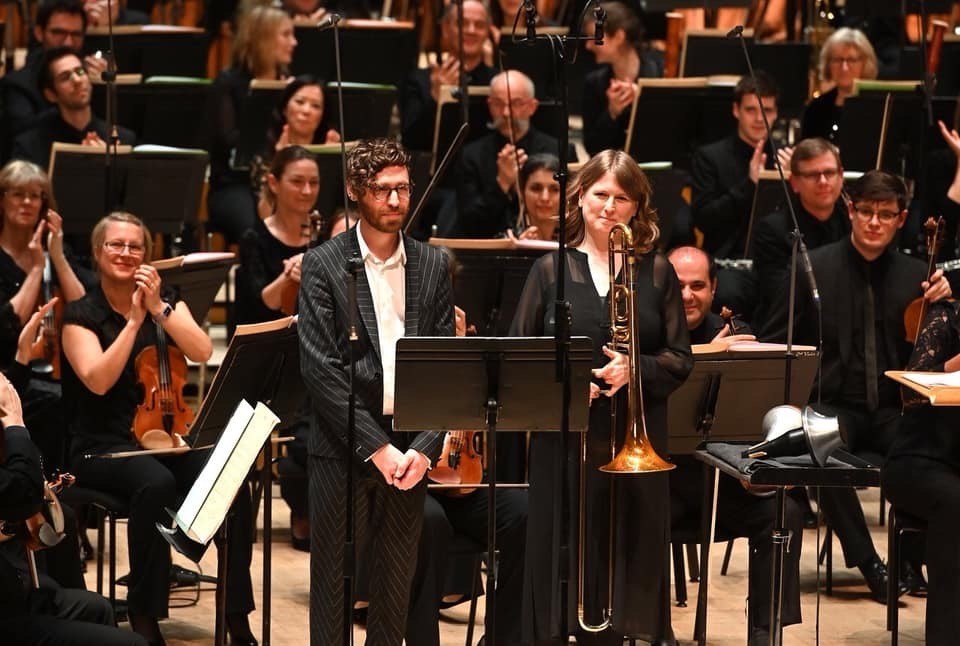Interview with Gavin and Helen from the British Trombone Society magazine, Winter 2018:
When was this piece first conceived, and how has it come into fruition?
GH: One or two years ago I actually went to the BBC Symphony about writing a clarinet concerto, which they were sort of keen on, but then they realised they’d commissioned quite a lot of wind concertos of late. So they asked if there was anything else I would like to do, and I said there has been a trombone concerto in my head, and I’d already spoken to Helen a bit about this. They went for it immediately! So that’s how this concerto began life.
Could you tell us a bit about your compositional process and how you’ve been developing this concerto?
GH: I’ve written quite a lot of music for solo instrument and brass band, but this is the first concerto with orchestra I’ve written. So it’s been quite a challenge to write, actually. I knew I wanted it to be quite a substantial piece. I didn’t want it to be 10-15 minutes and over. It’s about 24 minutes, quite a big piece, quite epic.
It’s not so much a person at the front who the orchestra sits behind having a dialogue. Helen is in the centre of the orchestra and the orchestra swirls around her throughout the piece.
There’s normally an extra musical inspiration for my pieces. A little while ago I came across a recently discovered 16th century German illuminated manuscript called The Book of Miracles. It’s an incredible book that depicts various supernatural phenomena, starting in the Old Testament and moving through historical events to the time when it was written. The last part is depictions of revelations. They are quite striking images, because they look incredibly modern – vivid, colourful and quite playful in a way. It’s full of comets and eclipses, and things falling form the sky. When I first discovered the book, I knew I wanted to write a piece on it. I thought it was going to be the clarinet concerto, but the trombone being a declamatory instrument, I thought it would be the right thing to explore with this piece. It’s in four movements: a substantial first movement that is nine or ten minutes long, a slow second movement going into the third which is full of extended cadenza, and a fast and furious finale.
You mentioned you chatted with Helen at the Last Night of the Proms a few years ago. Since then, while you’ve been writing the piece, has there been much collaboration and exchange of ideas between you and Helen, or has she just let you get on with writing it?
GH: A lot actually; every time I write something, I send it to her to have a go at – I’m writing a piece for her and the BBC Symphony, so I want to make sure it’s a piece she’s happy playing. Certain players have things they enjoy doing and things they don’t enjoy doing. So there’s been quite a lot of back and forth, which is good as I think the first sketch I sent her was verging on impossible! (Which is fine, my feeling is to get it all down first and clear out what doesn’t need to be there later.) We met up a few times, and tried things out. I’m a brass player, but I’m not a trombone player. I know the slide positions, but I don’t really know what the actuality of doing some of these things in real time is, so it’s been quite useful.
So often you’re sent off to do your thing and you hand it in at the end, which is quite a lonely process. But if you’re writing a concerto for a specific player, I think it’s important that you have a lot of contact with that person. Also, I think it puts Helen’s mind at rest, that I’m not just handing her a massive 24 minute concerto at the end of the process, and she’s actually getting to see it as it comes along.
What have you found are some of the opportunities with writing for the trombone and also some of the challenges?
GH: It has been quite a challenge actually, because when you think of a concerto you naturally think of extreme virtuosity. This piece is virtuosic, it’s quite a blow, there’s a lot going on, but it’s not the same type of virtuosity as on a violin or a clarinet. You have to readjust your head to the instrument, what it can do, what it sounds good doing, where the line is of what’s actually playable and what isn’t. Things like needing breaks and time to breathe and all the other things you have to take into consideration.
Have you used many extended techniques in the piece, or – in terms of techniques – is it quite conventional?
GH: There a few different mutes, and the end of the cadenza is sort of a glissando fantasy, full of glissandos and rips – but nothing too whacky! We played around with multi-phonics, but the music that I had in my head, and what needed to be done for it to work effectively didn’t quite match up, so we left that.
You’ve given us a good idea of what people can expect from this piece in terms of flavour and structure. What about the orchestral forces involved?
GH: It’s for full orchestra, triple winds, full brass; it does get quite big at times, but the middle section is slow, full of solo strings, with muted trombone over the top. In the first movement, while there’s a lot of activity, the harmonic language is quite static – it takes quite a long time for a chord to change. In the last movement however, they change basically every quaver or so.
Is there anything else you want to say?
GH: Helen’s such a classy player. At the very beginning she was adamant she wanted to be able to play everything, which is not to say ‘don’t make it hard’; she wanted to make sure every note was there. She wasn’t interested in bluffing, which is quite a nice thing to hear. So it’s nice to be working with someone who is very clear that what’s there is what she wants to play. It’s been a nice way into thinking about the trombone writing. I’m looking forward to it!
We also spoke to Helen and asked for her point of view.
How do your preparations for the performance fit into your busy playing schedule?
HV: I am devoting time away from my orchestral schedule to prepare for this piece, as solo and orchestral styles don’t particularly compliment each other. In my experience, in solo playing the sound can get much brighter and more direct than is often desirable for symphony orchestra playing. So I allocate certain days and weeks to focus on the new concerto.
Are there any challenges you have come up against so far whilst preparing this piece?
HV: Gavin’s piece is full of challenges and I’m very excited about rehearsing and performing it with my lovely BBCSO colleagues and Alexander Vedernikov in February. I’m hoping to get a f inished part later this month, but since the summer we have been trying various excerpts and ideas of Gavin’s. It’s been fascinating to watch the piece evolve. Gavin is a very talented composer and I feel incredibly fortunate to be able to collaborate with him on this exciting addition to the solo trombone repertoire. He’s even given me some bars rest!
This piece will be a major addition to the trombone repertoire, how have you seen the solo repertoire develop over your career?
HV: There has been a steady flow of new tenor trombone pieces coming into the repertoire since I was at music college. We must of course thank Christian Lindberg, Joseph Alessi, Ian Bousfield and John Kenny for their huge influence and energy, but also more recently Jörgen van Rijen, Håkan Björkman, Katy Jones, Matthew Gee and Peter Moore for actively commissioning original works for trombone. And hopefully with three major new trombone concertos (MacMillan, Higgins and Casken) having been performed in the UK within the same concert season, the trombone concerto will become a less rare beast in concert programming.

 Designed and built using Angular by Adam Woolf @
Designed and built using Angular by Adam Woolf @ 